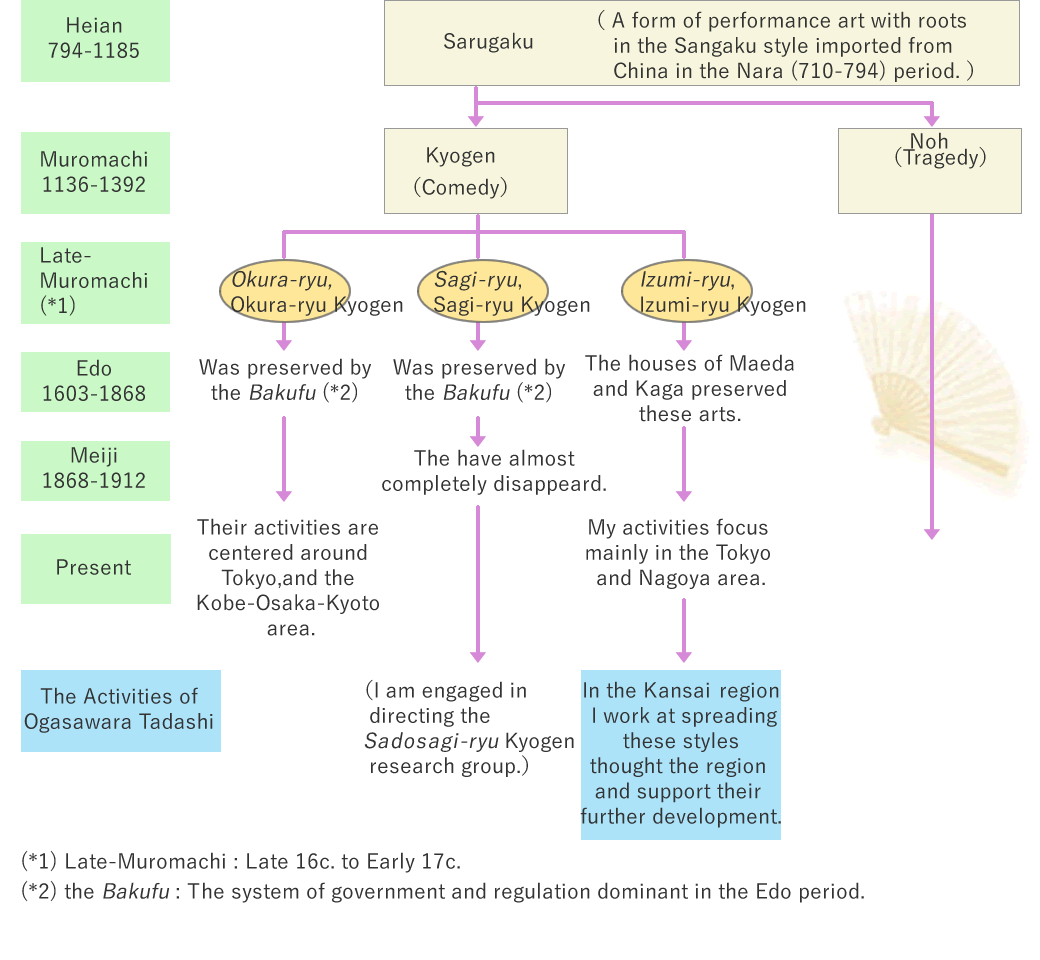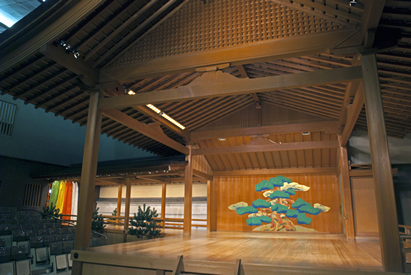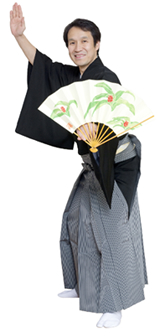Welcome to the Official Site of Tadashi Ogasawara, Kansai representative of Yorozu Kyogen as born of the Nomura Manzou Household. (Nohgaku Master Instructor/Performer in the Izumi-ryu form.)

 |
Who is Tadashi Ogasawra ? | KYOGEN |
|---|---|---|
| The Kyogen Classroom | Lectures and Workshops | |
 |
Encountering Kyogen | On Kubihiki |
Japanese performative art, a World Intangible Cultural Heritage
KYOGEN was originated during the KAMAKURA and MUROMACHI Period, in the14th century. It is the only theatrical entertainments in the world which have succeeded as long as 650 years. KYOGEN and NOH was registered as the 1st World Intangible Cultural Heritage in 2002.
Origin of KYOGEN
The two origins of KYOGEN may be traced back up to the ancient times. One is KAGURA, an ancient form of Shinto dance accompanying music. The other is SANGAKU which were introduced during the ASUKA and NARA Period from China of the ZUI and TOH Period.
SANGAKU included various forms of entertainments such as magic, jugglery, acrobatics, sorcery and others. Also it has been influenced both from GAGAKU, court music and from GIGAKU, masked drama. These two art forms were introduced from China at the same time with SANGAKU.
From SANGAKU to SARUGAKU and NOH
SANGAKU lost the patronage of the rulers in the HEIAN Period when the capital was transferred from Nara to Kyoto and at the same time became popular among the ruled. This art form combined Japanese ancient classical songs, instrumental music and performances and also it produced funny and mimic entertainments. It began to be called SARUGAKU, because “SARU” stands for monkey and a trained monkey is good at mimic of man. Also “SARU” is phonetically close to “SAN”.
SARUGAKU was divided into two parts, KYOGEN and NOH. They were brought up as ‘twin brothers’. KYOGEN is so-called farce, which often deals with human beings and lives, so sometimes is called as human comedy. On the other hand, NOH is a tragedy usually among aristocratic circles, gods and spirits. KYOGEN is a dialogic play with mainly speech while NOH is organized mainly by music and dance, thus called musical theater. KYOGEN dialogue comes from the common spoken language of the MUROMACHI Period while the language of NOH is highly literary in style.
SARUGAKU was polished further by ZEAMI, an unparalleled genius of player and producer, in the MUROMACHI Period. Under the patronage of following TOKUGAWA Shogunate, SARUGAKU became popular among samurai class.
Since the beginning of the new MEIJI era, SARUGAKU officially began to be called NOH, because “ SARU” is monkey itself and SARUGAKU stands for “playing like the ape” . “NOH-GAKU” is the general term of KYOGEN and NOH.
【 The history of Kyogen. 】

KYOGEN expressions about the change of scene and time
As he walks around on the stage, a KYOGEN actor can perform the change of scene and time instantaneously. The features of this expression are as a following example.
“I must hurry on my way. Truly, I have never been to Paris, there is nothing more amusing than the sightseeing worldwide. Today, I am certain I will enjoy myself. Well, here I have already come to Paris”. We could go to Paris in a second with the KYOGEN expressions..
KYOGEN performance must be enjoyed by full imagination!
The NOH stage is quite simple and KYOGEN does not need big stage settings and properties. A KYOGEN actor explains almost everything by his words and acting.
Accordingly, the audience of KYOGEN should be able to image freely everything on the stage by his sensitivity. In that sense, KYOGEN audience can take part in the drama itself. Indeed, this is the enjoyment to appreciate KYOGEN by maximized imagination.

KYOGEN actor uses fan for explaining everything.
|
An KYOGEN actor uses his fan for properties in order to express every things such as sake bottle, wine cup, chopsticks, writing blush, sword, handsaw and others. 
|

|
The way for Practicing KYOGEN
KYOGEN practice is made by instructing by words of mouth under the master.
KYOGEN has been inherited from the father to his son for by mouth to mouth.
Indeed this is the secret to success that KYOGEN have succeeded for long period, 650 years. For pupil practice starts from imitating all words of lines with a certain intonation and then after accomplishing all lines he can move to mimic master’s acting to practice until he can perform it automatically. Breathing from the abdomen and speaking with a loud voice is important. When he performs laughing he must use his whole body, not merely his mouth.
Schools of KYOGEN
Two KYOGEN of school exist at present, the IZUMI School and OOKURA School. There was previously another school called SAGI but its heritage died out during the MEIJI Period.
【 The different Styles of Kyogen. 】
| Izumi-ryu, Izumi style Kyogen |
Izumi style Kyogen is represented and maintained by, The Household of Nomura Manzo (Tokyo) The Household of Nomura Matazaburo (Nagoya) and The Kyogen Cooperative (Nagoya), and others. |
|---|---|
| Okura-ryu, Okura style Kyogen |
Okura style Kyogen is represented and maintained by the Shigeyama Sengoro-ke household (Kyoto), the Shigeyama Chuzaburo-ke household (Tokyo) and the Yamamoto Tojiro-ke household in (Tokyo) and others. |
Characters of KYOGEN
A lot of characters are involved in KYOGEN.
<Auspicious KYOGEN>
- (1) God
- Full of human and familiar feeling
Ex) FUKU NO KAMI (The God of Happiness) - (2) KAHO-MONO (Wealthy man)
- Ex) SUEHIROGAR (An Umbrella instead of a Fan)
- (3) Farmer
- About the happy harvest not about farmer’s daily life
Ex) SADOGITSUNE (The SADO Fox)
- TARO-KAJYA (and JIRO-KAJYA)
- Most common characters, general servant
Not only stupid but generally clever than his master
Ex) BO-SHIBARI (Tied to a Stick) - DAIMYO ( or Master)
- Master of TARO-KAJYA, bluffer but sometimes innocent and lovable
Ex) HAGI DAIMYO (The DAIMYOU and the Bush Clover) - YAMABUSHI
- Buddhist monk leading an ascetic life in fields and mountains
Sometimes betray ignorance and powerless
Ex) KAKI YAMABUSHI (The Persimmon Thief)

- ONI (Demon)
- Lovable one dressed the charming mask named BUAKU with sheep’s eyes.
Ex) SETUBUN (A Demon in Love) - MUKO (Groom)
- Sometimes end in failure because of little experience
Ex) FUTARI BAKAMA (Two People in One HAKAMA) - Man and Wife
- Always henpecked husband and strong wife
Ex) INABADO (A Bad Wife is Like a Bad Penny) - Priest
- Always corrupt priest, sometimes greedye
Ex) FUSE NAI KYO (Sermon without Donation) - Disabled man
- Almost blind person
Ex) KAWAKAMI (Blindness, Sight, and Blindness Again) - Aged person
- Feeling the grief of old age
Ex) MAKURA MONOGURUI(Grandfather in Love) - Thief
- Stupid and simple-minded, always end in failure.
Ex) URI NUSUBITO (The Melon Thief) - Seller
- Ex) SU HAJIKAMI (Vinegar and Ginger)
Classification by the types of laugh in KYOGEN
The types of laugh are very rich in contents of about 300 plays as follows.
- (1) Laugh by the plot
- -Laugh ended in catastrophe Ex) INABADO
- -Laugh of reversing Ex) TURIBARI
- -Laugh ended with unexpected result Ex) CHATUBO
- -Laugh of misunderstanding Ex) SANNIN KATAWA
- -Laughing that counterfeit come to light Ex) NIOU
- -Laugh of parody Ex) TSUUEN
- (2) Laugh by eccentric idea
- Ex) TSURIBARI, KAMINARI
- (3) Laugh by words
- -Laugh of language play and comic words Ex) SHUUKU GARAKASA
- -Laugh of local dialect Ex) GAN DAIMYOU
- -Laugh by onomatopoeia and mimic words Ex) BONSAN
- -Laugh by exaggerated words Ex) HAGI DAIMYOU
- (4) Laugh by acting
- -Laugh by pantomiming Ex) TSURI GITUNE
- -Laugh by exaggeration of action Ex) BUSU
- -Laugh by expression of actor’s face
- -Laugh occurred by contrast and unbalance Ex) HIGE YAGURA
- (5) Laugh by satire
- -Against the degradation of priest Ex) HUSENAI KYOU
- -Against the deterioration of religion Ex) SHURON
- -Toward YAMABUSI (Buddhist monk) of no ability
- -Against haughty behavior to servant
- -Toward the official who do unfairness Ex) SADO GITSUNE
- -Toward cunning seller Ex) AWASE GAKI
- (6) Smile warming audience’s heart, full of human feelings
- Characters appear in KYOGEN are always based upon humanity generally.
Ex) KONUSUBITO, UTUBO ZARU - (7) So-called WARAKU, stage effect occurred by joyful atmosphere and pleasant rhythmical KYOGEN songs
- Laughing aloud is not only pleasure but also being fascinated by self-intoxication is charm of viewing KYOGEN
- -Congratulatory joyful atmosphere Ex) HUKUNOKAMI
- -Feeling with rhythmical song Ex) KAGYU
- -Enjoying atmosphere with actor’s dance and song Ex) HINO SAKE
KYOGEN actor plays an important part even in the NOH drama.
KYOUGEN actor performs an important part called AI-KYOUGEN in the NOH.
There are three ways of performance
- Between the first half and the latter half of the NOH play, KYOGEN actor recites the theme speech about the drama.
- Sometimes KYOGEN actor opens his speech with explaining the situation at the beginning of NOH drama.
- Sometimes KYOGEN actor plays a supporting role in the NOH performance.
KYOUGEN songs (KOMAI-UTAI)
There are about 70 KYOUGEN songs. KYOUGEN actor recites the certain song in the drama at the scene of a drinking bout and the like. They include two kinds of song. One is sourced by the NOH drama or the parody of NOH. The other comes from the medieval old songs, Every songs are accompanied by dance. The practice of KYOGEN always starts from singing and dancing before playing KYOUGEN drama.
【 Kyogen-Noh Related Terms 】
| Shite | The main (lead) actor. |
|---|---|
| Ado | The role opposite the lead. |
| Tachishu | All other people on stage. |
| Kokata | The role played by a child. |
| Kouken | The person on stage, wearing a hakama with a crest patter on it whose responsibility is to help with the presentation of the performance on stage. His duties include activities such as bringing in the different props used on stag,e and making sure that the costumes are worn properly, etc. |
| Omote | In Kyogen, masks are not used as often as they are in Noh, but there are masks which represent gods, demons, spirits, the elderly, and animals, as well as emotions such as delight, anger, sadness, and happiness. The expressions are rich and folksy, and in their expression there is indeed a deep quality of humor. |
| Shouzoku | The costumes worn by the actors on stage. Kyogen has many simple elements and this sepparates it from Noh. |
 |
Who is Tadashi Ogasawra ? | KYOGEN |
|---|---|---|
| The Kyogen Classroom | Lectures and Workshops | |
 |
Encountering Kyogen | On Kubihiki |


